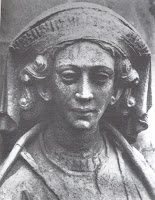Having finished rewriting, revising and fixing (in so many places), the fourth book in The Magiste Chronicles, I am taking a little breather before uploading and relaunching to get back to work on the fourth book in the Medieval Warrior's Legends series. This book, which I am calling Warrior's Witch, has a bit of paranormal angle, being that it features a time-traveling heroine – with a twist. And that twist has put me smack-dab in the middle of a dilemma, which I think I may have worked out. At least, I hope I did.
You see, our fearless heroine, Caroline, time-travels from the 21st century back to 13th century England, and meets our fearless hero, Simon. You may remember him as Gillian's bastard brother in Warrior's Possession. Anyway, as Caroline soon finds out, she technically time-traveled as an infant to the modern world, and knows nothing about the truth of her birth. As I originally wrote it, Caroline is the daughter of Simon's cousin. But then I realized that could have, not only an "ick" factor, but a very big legal issue, both then and now.
I had to take some time to dig deeper into the laws of the period, which raised the usual question – how realistic does this have to be? Naturally, writing historical romance requires a healthy degree of realism – you can't have characters from the medieval era saying/doing/using things that are common to today's world. And, of course, they have to abide by the laws of the land for their time. Most of the "common" people simply went along with it, no matter what their opinions might be. After all, enforcement of those laws in that era tended to fall on the side of lawlessness. Who dared go against a powerful monarch or overlord when he exacted justice by whatever means possible, no matter how unfair, cruel or brutal? If you spoke up, you just might meet a similar fate. But if you were nobility, you might be able to bend or even break the laws to achieve your goals, and you often got away with it.
Like everything else, where marriages were concerned, there were laws about who could or could not marry. As far back as Roman times, there were prohibitions on marriages through The Fourth Degree of Kinship, which included not only the first Three Degrees (parents, siblings, grandparents, uncles, aunts, nieces and nephews, etc.) but first cousins, and "greats" of all manner, as well. Many cultures and societies, as well as the Catholic Church, adhered to these various degrees for centuries. Generally, First and Second degrees were frowned upon, not only from a legal standpoint, but a societal one. That degree was just too close, and even in those days, which were rough, raw and brutal, that was an ick factor.
To avoid breaking the laws of the Church and the country/society they lived in, noble and royal families often kept detailed records of ancestry. However, throughout history these laws were not always adhered to – it was a lot easier back then to hide, ignore, or "lose" those records if you really wanted a marriage to occur. Additionally, breaking the laws could be permitted or forgiven by certain people in positions of power, for certain people in positions of power. For example, in medieval times, the Pope had the power to waive these marriage prohibitions, and these waivers most often occurred in the cases of royal couples. There were various reasons for these marriages, the whole "keep the bloodline pure" thing, to protect and keep lands the family currently held, and to strengthen a family's political power. On the flip side, many times, one spouse might use the laws on consanguinity to justify divorce or annulment, when they decided they wanted out of a marriage.
Another factor to consider is that, in those days, it took a lot longer for word to travel, so by the time word of this problematic relationship reached the ears of someone who could interfere, there could well be several children involved, which made for some sticky situations related to inheritances and such. Sometimes the marriages would be allowed to stand, other times, they were forced to be dissolved.
Edward I, one of my favorite English monarchs and a secondary character in more than one book in the Medieval Warrior's Legends series, remarried after his beloved Eleanor died. His second wife was Marguerite of France and was his first cousin once removed. Clearly, he received a dispensation, for she remained his wife until he died.
Naturally, as society and civilization evolved throughout time, so did the Roman Consanguinity Scheme; by the 11th century, Pope Alexander II had made sweeping changes, resulting in "Collateral Consanguinity." This now meant many more degrees now fell under the Fourth Degree - all relatives up to third cousins (formerly the Eight Degree) were included. Again, dispensations were made, and I personally suspect money and other forms of wealth or items of value changed hands to make these marriages happen.
In any case, in my story, I've made a few changes to Caroline's ancestry. I changed her father to now be Simon's second cousin, putting Caroline and Simon into the Seventh Degree, as per the Roman Scheme of Consanguinity. Despite the changes by the Church, they would likely be relatively safe from an ancestral and legal standpoint in those days. Though Simon is nobility, he is still bastard-born and unlikely to get a dispensation from the Pope to marry Caroline, who is already viewed with distrust, he would not likely be viewed as important enough to warrant bothering with.
At least, that's how I'm playing it!

